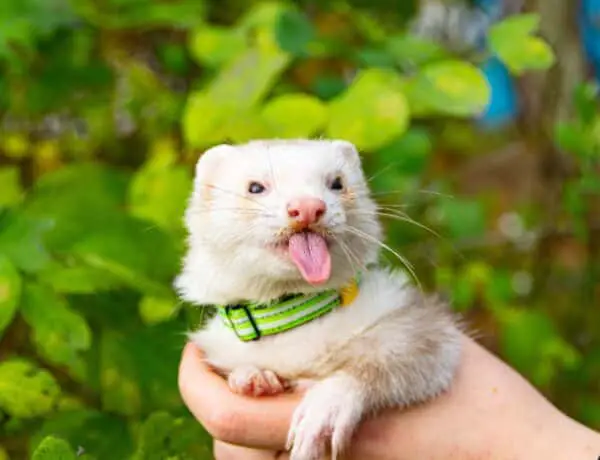Introduction
How To Train Ferrets: Ferrets, with their playful personalities and inquisitive nature, have captured the hearts of pet lovers worldwide. These endearing creatures, part of the Mustelidae family, are known for their mischievous antics and unique charm. However, for all the joy they bring, ferret fatten can also present some challenges to their owners, especially if they are not properly trained. This is where the art and science of ferret training come into play. Training ferrets can be an immensely rewarding experience, fostering a deeper bond between you and your furry companions while ensuring their safety and well-being. Whether you are a novice owner or a seasoned ferret enthusiast, understanding how to train ferrets effectively is essential to provide them with a happy, healthy, and enriched life.
The world of ferret training, covering essential techniques, tips, and tricks to help you navigate the journey of transforming your furry friends into well-behaved and socially adjusted pets. From teaching basic commands to litter training and preventing destructive behaviors, we will be the key aspects of ferret training. Ferret training is not just about imparting discipline fostering a relationship built on trust and understanding. Through positive reinforcement and patience, you can your ferrets to become obedient and responsive, all while preserving their unique personalities and quirks.
Whether you aim to teach them simple tricks, reduce nipping, or establish proper litter box habits, will equip you with the techniques needed to succeed. So, whether you’re a seasoned ferret owner seeking to fine-tune your training skills or a newcomer eager to embark on this exciting journey, it is your essential resource. Get ready to embark on an adventure of bonding, learning, and growth with your beloved ferrets as we unravel the secrets of train them with love and care.

Is it easy to train a ferret?
Ferrets are very trainable and if you’re patient, you will find training them no more difficult than training a cat. However, the number one mistake most people make is assuming that ferrets are like cats and will naturally use the litter box. This is not true.
Training ferrets can pose some unique challenges, primarily due to their inquisitive and often stubborn nature. Ferrets have a short attention span, and they’re known for their curiosity, which can lead them to explore every nook and cranny of your home. This can make it difficult to hold their focus during training sessions.
Age plays a significant role in the ease of training a ferret. Young ferrets, often referred to as kits, are more receptive to training than older ones. Kits are like sponges, eager to learn and adapt to new experiences. However, they also have shorter attention spans, so training sessions should be brief and frequent.
Individual temperament varies among ferrets, just as it does among people. Some ferrets may be naturally more cooperative and eager to please, while others may be more headstrong and independent. The latter group may require more effort and creativity in training.
Regardless of age or temperament, the key to successfully training a ferret lies in patience and consistency. Positive reinforcement methods, such as using treats or toys, can be highly effective in motivating your ferret to learn new behaviors. It’s essential to reward desired behaviors immediately and consistently while ignoring or redirecting unwanted behaviors.
How do you teach a ferret?
A few simple things, like making an alarmed, high pitched sound when bitten, holding your ferret by the scruff (the nape of the neck) and saying “no” in a very firm voice, or even hissing at the ferret when it bites will help to teach your ferret that nipping people and other things (like furniture) is wrong.
Litter box training is a priority when teaching a ferret. Ferrets are naturally inclined to use a designated area for elimination, making them relatively easy to litter train. Place a litter box in a corner of their enclosure and keep it clean. If your ferret starts to eliminate outside the box, gently place them in the box to reinforce the correct behavior.
Ferrets are social animals, so it’s crucial to socialize them with other ferrets, pets, and people. This helps prevent aggression and fear-based behaviors. Ensure that interactions are supervised, and start with short, positive. Gradually increase the duration of interactions as your ferret becomes more comfortable.
Ferrets need plenty of playtime and mental stimulation to stay happy and healthy. Provide a variety of toys and engage in interactive play sessions. Toys like tunnels, balls, and feathered wands are favorites among ferrets. Be sure to rotate their toys to keep them engaged.
Handling and taming your ferret is essential for their comfort and your ability to care for them. Start by gently picking them up and holding them for short periods. Use treats to reward calm behavior during handling. If your ferret is nippy, gently scruff them (supporting their body) and say “no” firmly. Avoid aggressive handling or punishment, as it can damage your relationship with your pet.
Crate training is valuable for trips to the veterinarian or travel. Your ferret to a crate gradually, making it a positive and safe space. Start with short sessions inside the crate, gradually increasing the time, and always reward them for entering willingly.
Are ferrets OK alone?
Ferrets are highly sociable creatures. They can be kept on their own, as long as they receive plenty of attention and play time from humans. If this is not possible, it might be best to keep more than one ferret. Ideally, ferrets should be kept either in a pair or a small group.
Adopt a Pair: The best way to ensure your ferret has companionship is to adopt two ferrets of the same sex. This provides them with a playmate to engage with, reducing loneliness and boredom.
Consider Rescue Ferrets: Many ferrets in rescue organizations are looking for loving homes. Adopting a rescue ferret can be a rewarding way to provide companionship to your existing ferret.
Supervised Playtime: Even if you have multiple ferrets, supervised playtime outside their enclosure. This allows them to interact and exercise in a safe environment.
Human Interaction: While ferrets benefit greatly from the company of their own kind, they also enjoy human interaction. Spend quality time playing and bonding with your ferrets to keep them mentally and emotionally stimulated.
Do ferrets ever cuddle?
Many ferrets like to snuggle with their humans. One thing you can try is getting a hoodie with a front pocket. Your furry little pal may like to curl up in there as you’re relaxing. You can also lie down on the floor with a blanket.
Affectionate Moments: Ferrets are known for their bursts of energy and curiosity, but they also have quieter, more affectionate moments. These moments often occur when a ferret is tired or seeking warmth and comfort. During these times, they may seek out their owner’s lap, snuggle into blankets, or curl up with other ferrets.
Sleeping Piles: In a group of ferrets, it’s common to see them pile together when they nap or sleep. This is a form of social bonding and cuddling, as they enjoy the warmth and companionship of their fellow ferrets.
Grooming Rituals: Ferrets are meticulous groomers, and they often groom each other as a sign of affection and bonding. If a ferret licks your hand or face, it’s their way of showing affection and trust.
Body Language: Pay attention to your ferret’s body language. A relaxed and content ferret will often have a slightly limp body when held or cuddled. If they’re enjoying the cuddle, they may even fall asleep in your arms.
Can a ferret learn its name?
As with training a dog, the best place to start is by getting the ferret to recognize her name and respond to it. To do this, say the ferret’s name over and over again. When your ferret finally looks up at you when you say her name, reward her with a treat.
Sound Association: Ferrets can learn to associate the sound of their name with specific interactions or events. For example, when you call your ferret by its name before playtime or feeding, they may come to recognize that sound as a cue for something enjoyable.
Repetition: Repetition is a key component of name recognition. Repeating your ferret’s name consistently during interactions can help reinforce the association between the sound and the ferret’s identity.
Tone of Voice: Ferrets are sensitive to tone and inflection in your voice. Using a consistent and gentle tone when calling their name can help them understand that you are addressing them.
Positive Reinforcement: Positive reinforcement, such as offering treats or affection when your ferret responds to their name, can encourage them to associate their name with positive outcomes.
Are ferrets fun pets?
Ferrets have an inquisitive and playful nature. They can learn to see humans as companions and form a strong bond with their owners. This makes them a popular pet choice because of their sociable and charming character.
Ferrets are renowned for their boundless energy and playful antics. They have a natural curiosity that leads them to investigate every nook and cranny of your home. This inquisitiveness often results in entertaining hijinks as they explore, jump, and frolic with infectious enthusiasm. Watching a ferret at play can be a source of endless amusement, making them fun pets to have around.
Ferrets are social animals, and their love for interaction is another reason they are considered fun pets. They form strong bonds with their owners and thrive on companionship. Whether it’s cuddling on the couch, engaging in playtime, or simply being by your side, ferrets are always eager to be part of the action. Their affectionate nature can bring a sense of joy and connection to your daily life.
Just like people, each ferret has its own distinct personality. Some ferrets are more outgoing and adventurous, while others may be a bit more reserved. This diversity in personality adds an element of surprise and excitement to ferret ownership. You’ll never quite know what antics or endearing quirks your ferret will display, keeping you entertained and engaged.
The bond you form with your ferret can be deeply rewarding. Their loyalty and trust in you create a unique and fulfilling connection. Many ferret owners describe their pets as constant sources of joy and companionship, making them feel loved and needed. This emotional connection is one of the most significant reasons ferrets are considered fun and beloved pets.
How old is 1 year in ferret years?
To gain perspective on their life span, each year of a ferret’s life is approximately equal to 10–14 years of a human’s life. As a result, health changes can occur quickly as your ferret ages. All ferrets should have a yearly physical examination.
Baby Ferrets (Kits): Ferrets are born in litters, and they are typically weaned from their mother around 6 to 8 weeks of age. At this stage, they are considered kits and are similar in developmental terms to human infants. Kits grow rapidly during the first few months of life, reaching sexual maturity at around 4 to 6 months.
Young Ferrets (Adolescents): Ferrets continue to grow and develop during their first year of life. By the time they reach 1 year of age, they are considered young adults. In terms of human years, some suggest that a 1-year-old ferret may be roughly equivalent to a human teenager in terms of development and energy levels. They are active, playful, and often at their peak of curiosity.
Adult Ferrets: Ferrets are considered fully mature at around 1 to 2 years of age. During this time, they settle into their adult size and temperament. In human terms, this stage could be compared to a young adult in their early 20s.
Senior Ferrets: Ferrets are considered seniors when they reach around 4 to 7 years of age. They may start to show signs of aging, such as a decrease in energy and agility. In human years, this stage could be compared to middle age and beyond.
Are ferrets good first pets?
Are ferrets a good pet? They are lively, curious and fun-loving pets, and they’re very social. This means that they can make great pets, but they’re not the easiest to handle and can bite hard if startled. So they don’t always make good pets for children.
Level of Commitment: Ferrets, like all pets, require a significant commitment in terms of time, attention, and care. They have specific needs that must be met daily, including feeding, social interaction, and exercise. First-time pet owners should be prepared for this level of commitment.
Social Interaction: Ferrets are social animals and thrive on human interaction and the companionship of other ferrets. Keeping a single ferret may not be ideal, as they can become lonely and bored when left alone for extended periods. Multiple ferrets require more attention and resources.
Habitat and Space: Ferrets need a safe and spacious enclosure with room for play and exploration. Their living space must be escape-proof and contain appropriate bedding, food, and water.
Healthcare: Like all pets, ferrets require regular veterinary care, vaccinations, and preventive measures. They are susceptible to specific health issues that necessitate attentive monitoring and prompt medical attention when needed.

Conclusion
Ferrets stand out as unique and lovable companions. Their boundless energy, inquisitive nature, and affectionate demeanor make them a cherished addition to countless households. However, as with any pet, fostering a harmonious relationship with ferrets requires commitment, patience, and a solid understanding of how to train them effectively. The ferret training is not merely about instilling discipline; it’s a multifaceted endeavor that enhances the quality of life for both ferret and owner. We’ve learned that building trust and forming a deep connection with these furry friends are at the core of successful training.
The principles of positive reinforcement, consistency, and patience have been emphasized repeatedly, underscoring their crucial role in shaping desirable behavior in ferrets. From the basics of teaching commands and litter training to addressing common behavioral challenges, has provided a roadmap for pet owners to navigate the unique world of ferret training. It’s essential to recognize that every ferret is an individual with its own personality, and the training process may vary from one furry companion to another. Flexibility and adaptability are key qualities that a ferret owner must possess.
Ferrets thrive in environments that cater to their curious minds, so providing them with enriching experiences and companionship is vital for their well-being. Building playtime into their daily routines not only exercises their bodies but also stimulates their intellect, reducing the likelihood of boredom-induced misbehavior. It’s a testament to the bond between humans and these enchanting creatures, a bond that deepens with every successful training session. So, embark on this adventure with an open heart and a willingness to learn, and you’ll reap the joy of a harmonious partnership with your ferrets for years to come.





No Comments